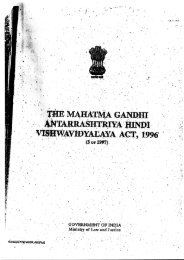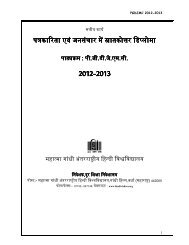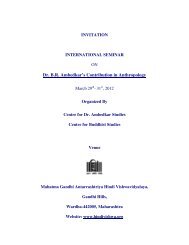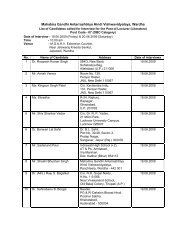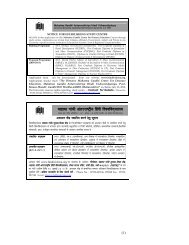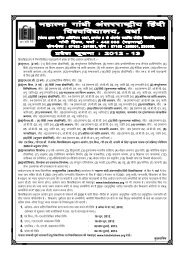fहndi - Mahatma Gandhi Antarrashtriya Hindi Vishwavidyalaya
fहndi - Mahatma Gandhi Antarrashtriya Hindi Vishwavidyalaya
fहndi - Mahatma Gandhi Antarrashtriya Hindi Vishwavidyalaya
You also want an ePaper? Increase the reach of your titles
YUMPU automatically turns print PDFs into web optimized ePapers that Google loves.
(emancipation) but also the reader (whois promoted by sattvik bhavas) toBrahmaloka (abode of Brahma).Here I am reminded of one of mydiscussions with Dr. Nagendra. He hadasked whether a good poem written onHitler would be regarded pragatisheel(progressive)? From the viewpoint ofsadharnikaran, this would certainly beregarded a progressive poem, for, from thispoint of view, both the individual and thetype dissolve into the indivisibility of thesoul. Since the social aspects of the subjectare not taken into account, anti-socialelements will also be included in it, andon the pretext of poetic purification theywill be called Brahmanand. The way thisdoctrine has been explained makes itresemble the European doctrine which isno longer acceptable there. This doctrineis known as "Art for Art's Sake". Babujino doubt wants that morality is notneglected/ignored, but if one asserts thatliterature should aim at the developmentof society, the spirituality (chinmayata) ofliterature will be endangered. Broadlyspeaking, there are two kinds of viewsregarding art. One view regards art as aninstrument of improving society, and itssuccess is measured from this point of view.The second view holds that art has nothingto do with the development or degradationof society; its success lies in providing anandor entertainment. Babuji states : "To believethat the purpose of art is above and beyonditself is to doubt its autonomy, and to dragit from the heaven of its independence tothe pit of darkness." How is this argumentdifferent from that of 'Art for Art's Sake'?If art is not supposed to be regulated bysocial influence, it will ultimately becomeanarchical, and it will neither lead to socialwelfare nor would it yield any anand. Itshould be kept in mind that the depictionor portrayal of an anti-social theme willnot yield any pleasure to majority ofpeople. Some people of the aristocratic classmay enjoy this kind of art, but how longwill they survive? It is, therefore, better totreat the subject-matter as the controller/regulator of art. Let art present the themeembellished with the help of all the devicesit has at its disposal so that we are ableto enjoy it. The acceptance of art as a meansof improvement of society does not refutethe claim that art affords us anand. It ispossible to find a few sahridayas andconnoisseurs in a feudal and capitalistsociety who derive pleasure only from thosethings which are inimical to the welfareof the larger community. But this is notinevitable. The modern critic should makethese things clear.Babuji has argued that when a medicaldoctor, who dissects dead bodies, and aneconomist do not think it necessary to havetraining in art, why should an artist degradehimself by consulting economists? In fact,the crux of the problem does not lie inturning art into economics or economicsinto art. The problem is whether the artistshould or should not write on social andeconomic issues, and if he writes, whatmethod should he adopt? However spiritualor indivisible an art might be, it cannotsurvive for a moment without materialfgndi •April-June 2013 :: 9



